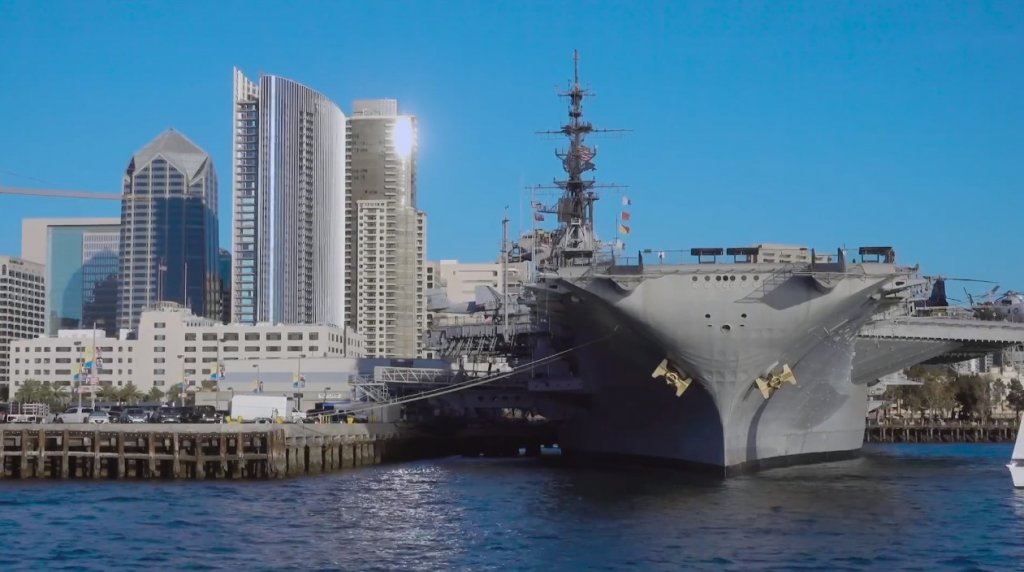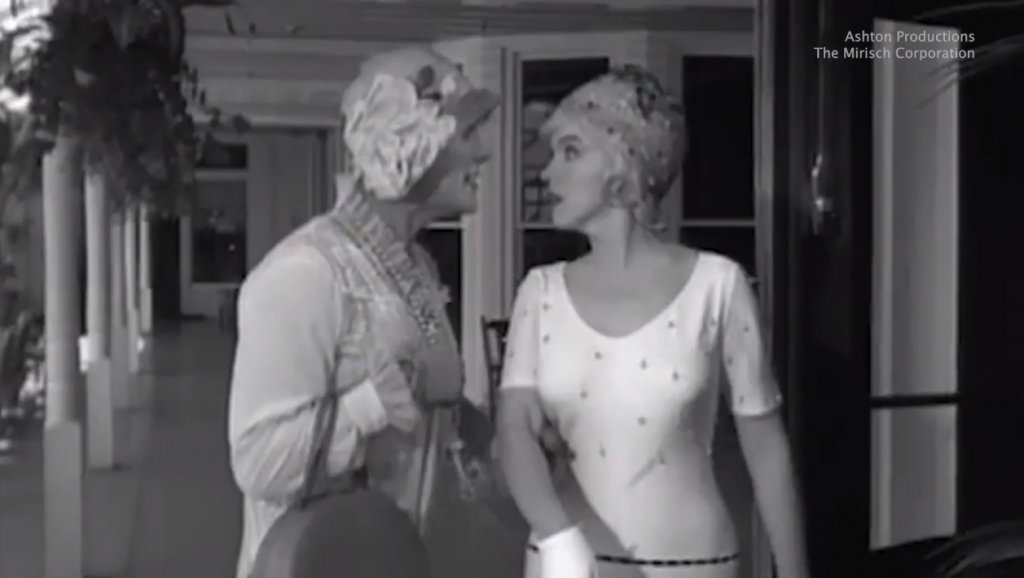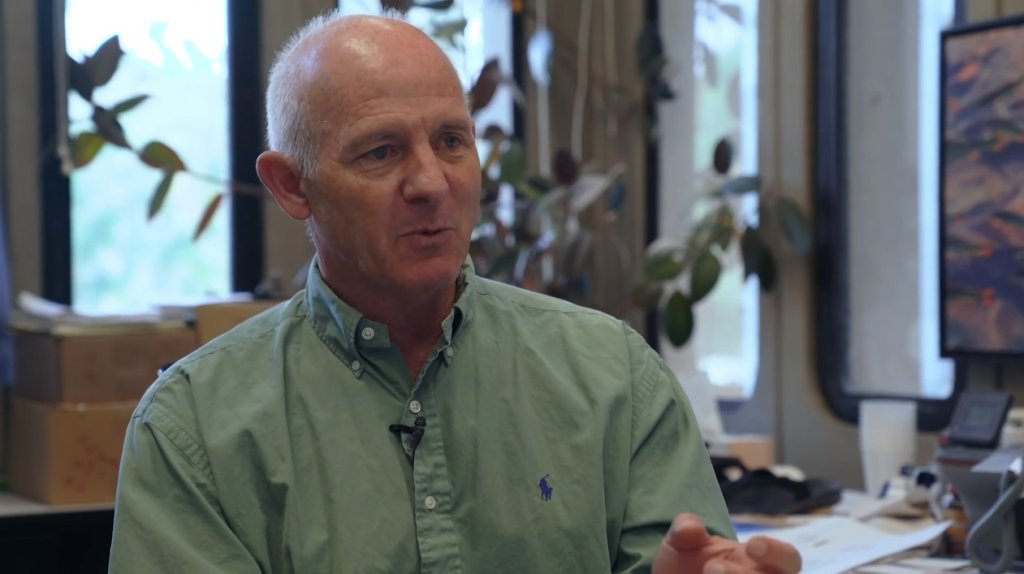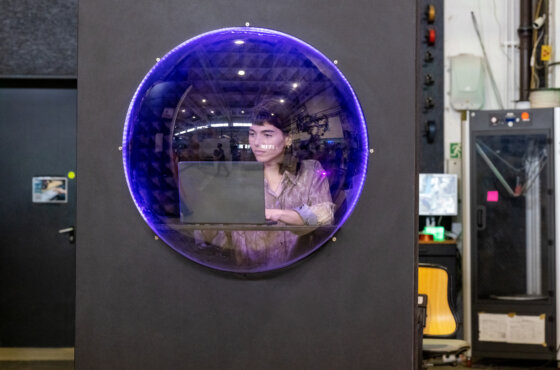Aircraft carriers, Comic-Con, border with Mexico and avocados: a great trip to San Diego
Here they know how to clean avocados, save the planet from plastic and hold the world's largest festival Comic-Con. In San Diego, fur seals roost on coastal cliffs, and Americans continually include the city on the list of the best for life in the United States. Offers a great trip to San Diego offers "Voice of America".

Photo: video frame "Voices of America"
San Diego is called the birthplace of California, it is one of the most populous cities in the United States. Here the highest concentration of the military, and this is not surprising: the city is the main base of the Pacific Fleet of the United States. It is a city of high technology and advanced scientific discoveries, conservative and liberal at the same time.
For a long time, San Diego was in the shadow of San Francisco and Los Angeles, but, according to local residents, the city only benefited.

Photo: video frame "Voices of America"
It is impossible to describe San Diego in one sentence. A city with a population of about 1,5 million people looks like a patchwork quilt: carefree surfers are adjacent to office workers, in the neighborhoods right on the border with Mexico, they tell terrible stories about drug cartels, and in San Diego Bay, sea landscapes are hidden behind the masts of the most powerful in the world aircraft carriers. It is a city of perfect weather, where there are no seasons and +20 degrees all year round. Climate, fertile land (in the city of almost 6000 farms) for centuries attracted new residents to San Diego.
The first colonists arrived here in the middle of the 16th century, but it will be almost 200 years before new settlements appear here. It was from this place that the story began not only of San Diego, but of the entire state of California.
In 1850, San Diego became part of the United States. The first warships arrived at nearby Cape Loma. The naval base in San Diego was founded in 1922. To this day, the Navy is the main employer in the city, where about 100 thousand military personnel live.
“San Diego is the birthplace of naval aviation. A hundred years ago, it was here that the first aircraft landings on aircraft carriers took place. It has the world's largest air base and the largest number of veterans. So when people come to San Diego, they want to learn as much as they can about the city's military history,” says naval historian Scott McGaw, director of marketing for the world's largest museum ship.

Photo: video frame "Voices of America"
McGaw talks about the story on board the USS Midway aircraft carrier, which served the US Navy for a record 47 years.
“It’s very difficult to understand how big and powerful Midway is until you’ve been here,” the historian says. “This ship is as long as three football fields.” 37 meters wide, 70 tons, 000 rooms. Solid steel. It is incredibly powerful: while the average car has 2000-200 horsepower, Midway engines produce 250.”

Photo: video frame "Voices of America"
The ship was launched a week after the end of World War II. For a decade, he remained the most powerful aircraft carrier in the world. The scale is amazing today: it is a real military base on the water, protected as a fortress, capable of accommodating 137 fighters.
“Aircraft carriers are always at the forefront, we call them pioneers,” says McGaw. - If things are bad, the first question the president asks is: “Where is our nearest aircraft carrier?” He sends him to Vietnam, to Korea - where there is a crisis. For anyone who served here, this was the pinnacle of their military career.”

Photo: video frame "Voices of America"
Midway's baptism of fire was the Vietnam War. And he ended his service half a century later, after Operation Desert Storm, the first in history won exclusively by air forces. Supersonic planes could easily take off from Midway, built in the 40s. 3000 sorties - and not a single loss. The air commander - Boss and his assistant Mini - were responsible for all air operations on deck, for every takeoff and landing, for the nearly 200 men, whose average age was 19, who loaded the bombs and refueled the thundering planes. These guys were on the high seas.
The conditions on the ship were also only for the hardened, while at the same time, 3000 people served on Midway. All but the officers lived in such cabins: three-level beds and no personal space. Most smoked, there was no air conditioning.

Photo: video frame "Voices of America"
Smoking was prohibited near fuel tanks and in some other parts of the ship, including during emergencies. But men still smoked in their free time. Many worked at night, so they did not turn off the light, they only dimmed from 19:00 to 7:00.
On the subject: A city of gangsters, dance and happy people: a great trip to Chicago
Completed Midway service in 1992. It’s hard to imagine, but they wanted to scrap the aircraft carrier. Or “on razor blades,” as Scott jokes. And only thanks to the efforts of volunteers it turned into a museum. During the first 15 years of its existence, the Midway Museum not only broke all records for popularity, but also became a very wealthy museum, earning $50 million over the years.

Photo: video frame "Voices of America"
The sense of duty and discipline of the military in San Diego surprisingly coexists with the carefree nature that can only be found in coastal cities. In the morning - yoga and jogging, in the evening - surfing and a freshly squeezed smoothie in one of the fruit bars, of which there are literally several in each block.
San Diego is, of course, a military city first and foremost, but secondarily a tourist city. 36 million people visit it annually. Tourism is San Diego's second largest economic sector.

Photo: video frame "Voices of America"
The fame of the world-famous resort came to the city with the opening of the Hotel Del Coronado. The first visitors were received here in 1888. Today the hotel, with its Victorian towers and façade, is one of the last surviving timber buildings of its time.
“Coronado was the largest electrified resort west of the Mississippi,” said hotel employee Gina Petrone. “It appealed to wealthy Americans, who usually came here for several months and brought with them all their household servants.”
11 US presidents came to Coronado to breathe the healing air. He became known to the general public thanks to scenes from films. Located just 2 hours from Hollywood, the hotel was often turned into a film set. It all started back in 1897, when the film “A Dog Playing with a Surfer” was filmed here. Then a lot of silent films were filmed here. In total, the staff counted 64 films and shows set in Coronado. The most famous was the 1959 film Some Like It Hot with Tony Curtis and Marilyn Monroe.

Photo: video frame "Voices of America"
Off-season, the cheapest room in Coronado costs $350. At its peak - a minimum of $800 per night. For example, when the world's largest Comic-Con festival takes place in July in San Diego, there are more celebrities here than in Hollywood. San Diego's cultural life can be divided into "before" and "after" Comic-Con. Tickets for the festival are sold out six months before it starts. The event lasts only 4 days, but for fans of comics, video games, television series and superheroes, the international Comic-Con festival is the hallmark of San Diego.
It all started in 1970, when a group of comic book fans gathered in a hotel in the city to discuss the latest in pop culture. They could not even imagine that these meetings would eventually turn into an international festival. During Comic-Con, entire neighborhoods are blocked off and houses are even repainted. Instead of the usual bricks, the facades are full of advertisements for TV series and movies. Instead of passersby there are heroes of films and comics.
For decades, the area where Comic-Con now takes place had a bad reputation as being home to bars and strip clubs where sailors would party after ocean storms. But in the 80s, city authorities began large-scale reforms and decided to build an exhibition complex here. It became the center of the new business and entertainment life of the city.
Comic-Con was first held at the San Diego Convention Center in 1995, at which time the prefix “international” appeared in the name of the festival - Comic-Con International. In just 4 days of Comic-Con, the city receives investments worth $150 million, and film presentations are attended by A-list actors - from Angelina Jolie and Scarlett Johansson to Tom Cruise and Arnold Schwarzenegger. The only thing that festival regulars are nostalgic about is the time when the focus of the festival was on cartoon characters, and not on their copies brought to life on the big Hollywood screens.

Photo: video frame "Voices of America"
The proximity of the Dream Factory in San Diego is felt in full: movie stars, sports stars and even politicians are willing to buy real estate in the fashionable areas of the city. Such, for example, as La Jolla, famous for Spanish architecture and white beaches. Convertibles, trendy electric cars, art galleries and spas are everywhere.

Photo: video frame "Voices of America"
Oceanfront homes sell for $20 million. This is despite the peculiar smell in La Jolla, which can kill the appetite of visitors even in local fine dining restaurants. Thanks to its special location, a very mild climate has formed in La Jolla Bay: it never gets colder than +10-12 degrees and even in summer the temperature rarely rises above +25. This pleasant climate was very popular with the local sea lions, who became one of the attractions of La Jolla Beach. They are also a source of constant odor, especially in areas near water. City authorities spray the rookeries with a spray, but this procedure is not allowed everywhere. And while the municipality is scratching its head, and local residents are covering their noses in disgust, happy tourists are photographing sea lions basking in the sun and joyfully posing with their families.

Photo: video frame "Voices of America"
Downtown San Diego houses one of the largest zoos in the United States. In just a few hours, you can visit the rainforest, the African desert and on an ice floe with polar bears. In the zoo, animals are not only fed, monitored and looked after in every possible way, but they also come up with an entertainment program for them. In fact, everything is like in kindergarten.

Photo: video frame "Voices of America"
But the main pride of the zoo is the list of animals that were returned to the wild. It already has 44 species, and this is just the beginning.
“We work on more than 140 projects in 60 countries, and we have a lot of stories with happy endings,” says zoo employee Elisa. “Our program dedicated to pandas, as well as the California condor, was a great success. We have been able to restore the population of these birds from there being only about 22 left in the early 80s to now there are more than 400.”
The zoo is located in Balboa Garden - this is one of the oldest parks in the United States and, perhaps, the main attraction of San Diego: its famous corners are depicted on postcards, cups and magnets. The park covers an area of almost 500 hectares - it is not only larger than New York's Central Park, but also the largest park in North America. There are 17 museums, a huge number of park areas and architectural monuments. Balboa Park in many ways reflects the history of San Diego itself: during the First and Second World Wars, the military was stationed here, and in the turbulent 60s, the Beatles and Rolling Stones performed here.
In Balboa Park, everything is reminiscent of the period of Spanish colonization - and in the city itself, as throughout California, they speak two languages. San Diego is located right on the border with Mexico. This checkpoint is considered the busiest not only in the United States, but throughout the world.
“We are standing on the US border from San Diego. Behind is Tijuana, a Mexican border town,” says activist and human rights activist Pedro Rios.
Tijuana is San Diego's closest neighbor. The city with the world's highest murder rate per capita. It is fenced off from the United States by two border walls.
“The one further down is the new fence. Previously, the height of the wall was 3,5 meters, and the new one is higher than five,” says Rios. “The closer wall will be completed before the end of the year; it will be three floors high.”
San Diego is often at the epicenter of migration crises. Pedro helps those who, fleeing persecution in their home country, are trying to obtain asylum in the United States. According to FBI statistics, San Diego (like El Paso, Texas) is one of the safest cities, he said.
“It’s very disappointing to hear on the news that there are criminals coming across the border,” says Rios. - This is wrong. But people who don't live in border towns don't believe this. Cities on the border are the real gateways to the cultural and economic development of the country. A lot of products and labor are imported from Mexico to the United States.”
America really cannot be fed without Mexican vegetables, but San Diego is a completely autonomous city. The most popular concept in recent years is “farm to table.” Only organic and only locally grown. These are the products offered in the Staley family stores.
“People trust our name,” said Stehly Farms Market owner Christina Staley. - This is synonymous with quality. We have been supplying San Diego County with vegetables and fruits for the past 20 years. We have collaborated with the biggest stores and people know our products.”
Avocado toast is the king of all kinds of breakfasts, brunches and lunches, not only in America, but also quickly gaining popularity all over the world. In the United States, most avocados are grown in San Diego. Avocado is very popular, it's a trend.
“When I graduated from college, we had a record harvest in California, something like 27 million kilograms. Farmers earned about 25 cents per kilogram. And today we grow billions of kilograms and earn more than 2 dollars per kilo. This is because popularity and consumption have grown enormously,” says Christina’s husband Noel Staley, a third-generation farmer.
Noel grew up in San Diego and wanted to be a Secret Service agent, and received a master's degree in international relations. But I soon realized that real passion is a family affair. Noel runs the farm with his brother. Under their leadership, the business model changed: they began packing their own fruit, expanded their range, received organic certificates and opened stores. There is no competition with Mexico, the largest supplier of avocados in the US market, Noel says, because local producers can only supply 20% of the demand.
“Each of us - in Mexico, Chile, California - has our own market segment. People know our brand: what it looks like, what it tastes like, and the taste is really different,” explains Noel. “If anyone is suffering from Mexico, it’s Chile.”
Despite the popularity of avocados, the golden vein green fruit did not. Due to the sharp jump in water prices, San Diego began to lose its status as the capital of avocados.
“Avocado production in San Diego County depends on the amount of water available,” Noel says. “It is brought here by canals from the Colorado River and northern California. Farmers can only take what is left after meeting the needs of the population. But as the population has grown and supply has not, water prices have gone up.”
On the subject: Active volcanoes, lava fields and the world's most powerful telescopes: a trip to the island of Hawaii
The city imports up to 90% of the water intended for consumption. Deficit primarily affects farmers, many of whom go out of business. Noel complains about other restrictions, he recently sold to Arizona a piece of equipment that, according to California laws, is outdated and emits too much carbon dioxide. However, even despite the difficulties, he remains in his beloved business. And even, according to him, he doesn’t eat oranges not from his garden, even if someone picked them for him.
Between them, Noel and his brother have six daughters, three each. The girls have not yet decided whether they will continue the family business of growing avocados and fruits.
Noel shared a secret on how to clean an avocado.
“Here’s my theory,” he says. - You just need to cut it into two halves, then prick the bone with a knife and turn it over. And then you can eat straight from the halves.”

Photo: video frame "Voices of America"
Stephen Mayfield, a professor at the University of California at San Diego, is also cultivating green plants. Using biotechnology, he turns it into oil and plastic. In Mayfield's laboratory, the shelves are lined with flasks containing green liquid. The poisonous substance is an algae, the so-called duckweed, which collects on the surface of the water. 30 years ago, Stephen began studying this primitive plant to understand how genes influence phenotype - color or size. However, I soon came to the conclusion: a simple algae is not so simple.
“We call it domestication,” Stephen shares. “This can best be seen in the example of dogs or agricultural plants. But let's take the dogs. In the past they were wolves or coyotes, and they weren't much of a pet. But then over a thousand years, due to changes in genetics, due to crossing and selection, we turned them into domestic animals - for example, such as Chihuahuas. We change the genetics to make a guard or hunter dog. We can do the same thing with algae: we teach it to be what we want."

Photo: video frame "Voices of America"
By manipulating molecules and genes, Stephen was able to turn algae into a medicine to treat viral infections, and then into fuel. It turned out to be too expensive to replace gasoline with algae - all due to the boom in the electric vehicle market and the offshore revolution in the United States.
“I won't say we wouldn't have been able to price competitively,” Mayfield says. “We could increase efficiency, but no industry goes from zero to competing with the world’s largest industry.” It just doesn’t work that way.”
Mayfield’s experiments did not end there; now his main goal is to put humanity in these slippers.

Photo: video frame "Voices of America"
They, of course, are also made from algae and can dissolve in water in just 2 years. This will help solve one of the key problems of environmental pollution from plastic waste. Seaweed flip-flops are very difficult to distinguish from plastic ones. They look exactly the same and last for several years. The most important difference is that these flip-flops are dissolvable. The University of San Diego already has agreements with major shoe manufacturers to develop special models. Stephen, meanwhile, assures: algae can not only cleanse the planet, but also feed it.
“The future is in products that don’t require a lot of water and land to grow,” says Stephen. “These resources are increasingly in short supply. The population is growing, which means we will need more protein. And algae can provide it for us.”
San Diego does not live by patterns. The US Naval Power Center and the capital of superheroes, a beach paradise and border checkpoint, a mecca for farmers and celebrities.
No matter how different its inhabitants may be, in San Diego everyone finds their own marina. Whether it is the first California colonists or modern dreamers, the magic of these streets easily turns guests into citizens.
Read also on ForumDaily:
16 free apps for travelers who don't need internet access
10 new bans in 2020 that you need to know about in order not to get into an awkward situation abroad
For adrenaline lovers: 9 of the most extreme amusement parks in the world
How to effectively learn a foreign language if you are already an adult
Subscribe to ForumDaily on Google NewsDo you want more important and interesting news about life in the USA and immigration to America? — support us donate! Also subscribe to our page Facebook. Select the “Priority in display” option and read us first. Also, don't forget to subscribe to our РєР ° РЅР ° Р »РІ Telegram and Instagram- there is a lot of interesting things there. And join thousands of readers ForumDaily New York — there you will find a lot of interesting and positive information about life in the metropolis.











